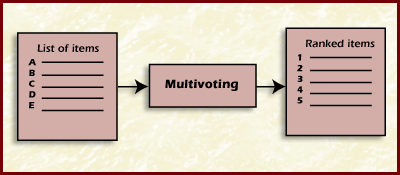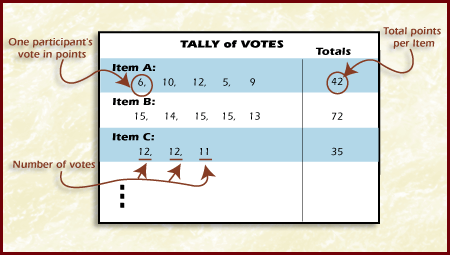

The purpose of Analyze was to convert the Statement of risks and list of risks into decision-making information. Analysis was the process of examining the risks and context statements in detail to determine the extent of the risks, how the risks relate to each other independently or in a set, and which risks are the most important. Analyzing risks has three basic activities: evaluating the attributes of the risks (impact, probability, and timeframe), classifying the risks, and prioritizing or ranking the risks.
After the Analyze phase of the paradigm is complete, the shaded areas of the Risk Information Sheet are filled in.
Figure Risk Information Sheet After Analyze
The method and tools along with their descriptions are given in the Table Methods and Tools. There is also a Blackboard folder containing each tool giving when to use the tool and their benefits.
The multivoting method is a general voting method. It can be used to conduct a straw poll or select the most important items from a list with limited discussion and limited difficulty. For a large number of items, a series of votes is used to reduce the list to a workable number [Scholtes 88]. Each participant in the process votes on the items in the list.
There are many variations on how to conduct the voting. This chapter outlines the SEI Risk Management Program's experience in conducting the multivoting method.
The Figure Multivoting Description shows the input and output for multivoting.

Multivoting Description
Personnel Requirements
The multivoting method requires a group of at least three participants. One person should be the facilitator and recorder (but he or she could still participate or contribute).
The systems engineer would use this method:
Assume that item X is more important than item Y. The engineer does not know how much more important item X is than item Y.
One constraint is that selecting the most important items from a large list (>20) cannot be achieved with one vote. A series of votes will be necessary to determine the priority of the top few items.
The benefit of multivoting is the method
The steps and action the fascinator should perform to conduct a multivoting session are described in the Table Multivoting Steps and Actions.
Table Multivoting Steps and Actions
|
Step |
Action |
|---|---|
|
1 |
Review items for understanding. Facilitator ensures that all participants understand the items on the list. |
|
2 |
Select voting criteria. This depends on the project objectives and constraints. The participants must decide what criteria are appropriate to use for ranking based on what's important to the project. Examples
|
|
3 |
Select number of votes. Selecting the number of votes to be used depends on the number of items on the list. A general rule of thumb for the facilitator is to allow participants votes equal to one-third the number of items on the list [Scholtes 88, p. 2-41]. |
|
4 |
Conduct voting. Each participant votes individually. Note: There are two weighting variations.
|
|
5 |
Rank items. The facilitator calculates the final ranking.
|
|
6 |
Review the ranking with participants. The Facilitator reviews the results and allows the participants to react to and discuss the resultant ranking. |
|
7 |
If the outcome us uncertain, repeat steps 3-6. For a large number of items, the final ranking may not be sufficiently distinct for the top items. In that case, reduce the list by removing items with few or no votes and conduct the voting again. This time members will have fewer votes to cast and the ranking of the top items will reflect the new vote. |
A sample voting form that each participant is given to fill out is given in the Figure Voting Form.

The Figure Voting Tally is an example of a tally form [Scholles 88] used to combine all individual votes. The total points per item are used to rank the items. In reviewing the ranking with the participants, the number of votes received per item can shed some light on why items were ranked a specific way. Did all the participants vote for an item but give it a low weight? Or did a few participants vote for the item and give it a high rank?
Used in this example is that Item A received 5 votes with a point total of 42. Item B received 5 votes with a point total of 72. Item C received 3 votes with a point total of 35.
If all votes were of equal weight, then the number of votes equals the number of points.

When the list is greater than 20 items, the participants must cast a series of voles to determine the priority of the top few items.
The participants may choose a variety of ways to conduct the multivoting steps. For example if anonymity is not an issue, the participants could all put their votes on the same flipchart in the front of the room. They should conduct the method using media that works for the group.
The participants should use a graphic display to show the results bar chart or pie chart. This visual aid helps the participants to see why the ranking came out as it did and which items are close in the number of points and votes.
Figure Voting Tally Example is another example of a tally form used to combine all individuals' votes. There are 5 participants; there are a total of 12 risks so each participant gets 3 (or 4) weighted votes. I will choose 3 votes to decrease the number of times to cast the votes. Selecting the number of votes to be used depends on the number of items on the list. A general rule of thumb is to allow participants votes equal to one-third the number on items on the list. Use the criteria that the higher the point value is the higher the risk (3 equals higher risk).
|
Participant |
Risk |
|||||||||||
|
|
A |
B |
C |
D |
E |
F |
G |
H |
I |
J |
K |
L |
|
Person 1 |
3 |
|
1 |
|
|
|
|
2 |
|
|
|
|
|
Person 2 |
|
3 |
|
|
|
|
|
2 |
|
1 |
|
|
|
Person 3 |
2 |
|
1 |
|
|
|
|
3 |
|
|
|
|
|
Person 4 |
1 |
2 |
|
|
|
|
|
3 |
|
|
|
|
|
Person 5 |
|
2 |
1 |
|
|
|
|
3 |
|
|
|
|
|
|
|
|
|
|
|
|
|
|
|
|
|
|
|
TOTALS |
6 |
7 |
3 |
|
|
|
|
13 |
|
1 |
|
|
There are 5 participants, 12 risks and three votes with weights 1,2 and 3. After everyone has voted the totals for each risk are tallied and in this example H is the highest, B next and then A, C and J. The other risks did not get any votes.
In summary no project has unlimited resources to mitigate risks. The risk team must determine what risks are most important and focus their resources on mitigating those risks. These are the "top N" risks.
The way the tame determines the top N risks are:
The risk information sheet after analyzes was shown. The methods and tool and their description for the analyze phase were given. The multivoting method was explained with an example.
[Scholtes 88] Scholtes. Peter R. The Team Handbook: How to Use Teams to Improve Quality. Madison, WI.: Joiner Associates, Inc., 1988.
[Xerox 92]Xerox Corporation and Carnegie Mellon University. The University Challenge: Problem-Solving Process User Manual. Stamford, Ct.: Xerox Corporation, 1992.
© January 1, 2006 James C. Helm, PhD., P.E.